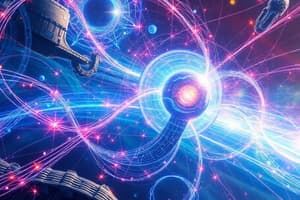Podcast
Questions and Answers
Which of the following statements correctly describes Newton's 1st Law of Motion?
Which of the following statements correctly describes Newton's 1st Law of Motion?
- An object will accelerate unless a force acts on it.
- An object remains at rest or in uniform motion unless acted upon by a net force. (correct)
- An object in motion will eventually come to rest due to friction.
- For every action, there is a force equal to its mass.
What formula represents the relationship between force, mass, and acceleration according to Newton's 2nd Law?
What formula represents the relationship between force, mass, and acceleration according to Newton's 2nd Law?
- F = m + a
- F = ma (correct)
- F = m/a
- F = m - a
Which type of energy is described by the formula PE = mgh?
Which type of energy is described by the formula PE = mgh?
- Potential Energy (correct)
- Mechanical Energy
- Thermal Energy
- Kinetic Energy
Which law states that the entropy of an isolated system always increases?
Which law states that the entropy of an isolated system always increases?
What is the primary characteristic of mechanical waves?
What is the primary characteristic of mechanical waves?
According to Ohm's Law, what is the correct relationship between voltage, current, and resistance?
According to Ohm's Law, what is the correct relationship between voltage, current, and resistance?
What do quantum mechanics primarily study?
What do quantum mechanics primarily study?
Which fundamental force is described as an attractive force between masses?
Which fundamental force is described as an attractive force between masses?
Flashcards are hidden until you start studying
Study Notes
Key Concepts in Physics
1. Mechanics
- Kinematics: Study of motion without considering its causes; involves displacement, velocity, acceleration, and time.
- Dynamics: Examines the forces and torques that cause motion.
- Newton's Laws of Motion:
- 1st Law: An object at rest stays at rest, and an object in motion stays in motion unless acted upon by a net force.
- 2nd Law: Force equals mass times acceleration (F = ma).
- 3rd Law: For every action, there is an equal and opposite reaction.
2. Energy
- Kinetic Energy (KE): Energy of an object due to its motion; KE = 1/2 mv².
- Potential Energy (PE): Energy stored in an object due to its position; gravitational PE = mgh.
- Conservation of Energy: Energy cannot be created or destroyed, only transformed from one form to another.
3. Thermodynamics
- Laws of Thermodynamics:
- 1st Law: Energy is conserved in a closed system.
- 2nd Law: Entropy of an isolated system always increases.
- 3rd Law: As temperature approaches absolute zero, entropy approaches a constant minimum.
- Heat Transfer Mechanisms: Conduction, convection, and radiation.
4. Waves and Oscillations
- Wave Properties: Wavelength, frequency, amplitude, speed.
- Types of Waves:
- Mechanical Waves: Require a medium (e.g., sound waves).
- Electromagnetic Waves: Do not require a medium (e.g., light).
- Simple Harmonic Motion: Motion of a system about an equilibrium position; described by periodic functions.
5. Electricity and Magnetism
- Electric Charge: Fundamental property of matter, can be positive or negative.
- Ohm's Law: Voltage = Current x Resistance (V = IR).
- Magnetic Fields: Region around a magnet where magnetic forces can be observed.
- Electromagnetism: Interaction between electric currents and magnetic fields.
6. Modern Physics
- Quantum Mechanics: Study of particles on a very small scale, where classical physics fails. Key principles include wave-particle duality and uncertainty principle.
- Relativity: Einstein's theory explaining how space and time are linked for objects moving at a constant speed in a straight line.
- Special Relativity: Deals with observers in uniform motion.
- General Relativity: Describes gravitation as a curvature of spacetime caused by mass.
7. Fundamental Forces
- Gravity: Attractive force between masses.
- Electromagnetic Force: Acts between charged particles.
- Weak Nuclear Force: Responsible for processes like beta decay in atoms.
- Strong Nuclear Force: Holds protons and neutrons together in the nucleus.
8. Applications of Physics
- Engineering: Application of physics principles to design and build structures, machines, and systems.
- Astrophysics: Study of celestial bodies and phenomena.
- Biophysics: Application of physics to biological systems.
These notes provide a high-level overview of fundamental principles in physics, aiding in the study and understanding of the subject.
Mechanics
- Kinematics studies motion without considering its cause. It deals with displacement, velocity, acceleration, and time.
- Dynamics investigates the forces and torques that cause motion.
- Newton's Laws of Motion describe the relationship between forces and motion.
- First Law: An object at rest stays at rest and an object in motion stays in motion with the same speed and in the same direction unless acted upon by a net force.
- Second Law: Force is equal to mass times acceleration (F = ma).
- Third Law: For every action, there is an equal and opposite reaction.
Energy
- Kinetic Energy (KE) is the energy of an object due to its motion. It is calculated as KE = 1/2 mv² where m is the mass and v is the velocity.
- Potential Energy (PE) is stored energy due to an object's position or configuration. For example, gravitational potential energy is calculated as mgh where m is the mass, g is the acceleration due to gravity, and h is the height.
- Conservation of Energy states that energy cannot be created or destroyed, only transformed from one form to another.
Thermodynamics
- Laws of Thermodynamics describe the relationships between heat, work, temperature, and entropy.
- First Law: Energy is conserved in a closed system.
- Second Law: Entropy of an isolated system always increases.
- Third Law: As temperature approaches absolute zero, entropy approaches a constant minimum.
- Heat Transfer Mechanisms involve conduction, convection, and radiation. Conduction involves heat transfer through direct contact, convection relies on fluid movement, and radiation involves electromagnetic waves.
Waves and Oscillations
- Wave Properties include wavelength, frequency, amplitude, and speed.
- Types of Waves:
- Mechanical Waves require a medium to propagate (e.g., sound waves).
- Electromagnetic Waves do not require a medium (e.g., light waves).
- Simple Harmonic Motion refers to the periodic motion of a system about an equilibrium position. This motion is described by periodic functions like sine and cosine.
Electricity and Magnetism
- Electric Charge is a fundamental property of matter that can be positive or negative.
- Ohm's Law states that voltage (V) is equal to current (I) multiplied by resistance (R): V = IR.
- Magnetic Fields are regions around magnets where magnetic forces can be observed.
- Electromagnetism describes the interaction between electric currents and magnetic fields.
Modern Physics
- Quantum Mechanics investigates particles on a very small scale. Key principles include wave-particle duality and the uncertainty principle.
- Relativity, Einstein's theory, explains how space and time are linked for objects moving at a constant speed in a straight line.
- Special Relativity focuses on observers in uniform motion.
- General Relativity describes gravitation as a curvature of spacetime caused by mass.
Fundamental Forces
- Gravity is an attractive force between masses.
- Electromagnetic Force acts between charged particles.
- Weak Nuclear Force is responsible for processes like beta decay in atoms.
- Strong Nuclear Force holds protons and neutrons together in the nucleus.
Applications of Physics
- Engineering applies physics principles to design and build structures, machines, and systems.
- Astrophysics investigates celestial bodies and phenomena.
- Biophysics applies physics to biological systems.
Studying That Suits You
Use AI to generate personalized quizzes and flashcards to suit your learning preferences.




